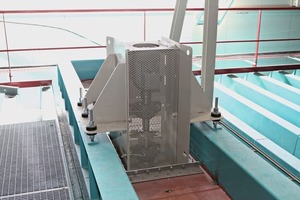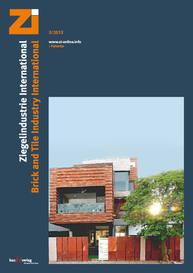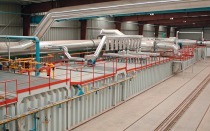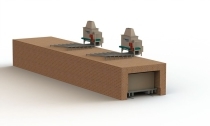Energy is now the primary focus of the research efforts made by Ceric Technologies with the aim of developing new technologies for the clay brick and tile industry. These research activities cover many different areas, from the use of alternative fuels through the reduction of atmospheric pollution to improvements in energy efficiency and thermal insulation of plants. The goal of cutting energy consumption has been applied to the entire range of machines produced by Ceric. One example is the Pelerin extrusion unit, the exit auger tube of which has been modified leading to a a 10% reduction in energy consumption. The most important areas for these developments, however, are kilns and dryers.
› Firing: kiln insulation
Kiln characteristics are constantly changing in terms of insulation and thermal efficiency.
› Alternative energy sources
Recent developments in the field of alternative fuels have resulted in the use of new energy sources such as producer gas, biogas and sawdust.
Biogas is a renewable non-fossil fuel produced in technical landfill centres through the fermentation of organic matter. Consisting essentially of methane, carbon dioxide, water and other gases in smaller proportions, its heating power varies from 4 to 7 kWh/Nm3 depending on the concentration of methane. Ceric Technologies boasts proven expertise in the installation of bi-energy firing plants (biogas/natural gas). This solution consists of biogas units to supply the firing zones, jet burners and bi-energy nozzles and allows for automated management. The fuel changeover requires no operator intervention and the continuity of firing is guaranteed even in the event of an interruption in the supply of one of the fuels. Biogas is cheaper and more eco-friendly and offers a reliable alternative to the use of fossil fuels. The system can be adapted to new and existing plants.
Sawdust, bark and wood chips, pellets and other plant waste are carbon-neutral fuels. The heating power of sawdust depends on its moisture content and may vary significantly. Ceric Technologies has developed a firing system capable of operating with all types of moist sawdust without the need for preliminary drying. However, the sawdust must be sieved and grains larger than 5 mm eliminated before it is fed to a chain conveyor which in turn feeds the augers connected to the firing plants. Each plant is automatically regulated and sends a mixture of air and sawdust to the nozzles installed in the kiln, which is equipped with an automatic jet shutting device to prevent combustion of the sawdust and return of the hot gas to the firing plants.
› ThermoBooster
Ceric Technologies has also made efforts to further improve the performance of the firing plants (gas impulse nozzles, jet burners) so as to make them compatible with the use of alternative energy sources and to optimize heat exchange during firing. Initial flue gas recycling and subsequent high-temperature mixing have proven to be effective solutions for reducing energy consumption. ThermoBooster, the new recirculation system developed by Ceric Technologies, is able to optimize flows in the kiln and make the temperature uniform in the various sections by reducing the temperature difference between the upper and lower sections of the kiln car. The high-temperature air mixing system has the unique characteristic of functioning inside the kiln at a temperature range of between 200° C and 850° C. It does not require the installation of external air pipes which are prone to corrosion and difficult to inspect. Its efficiency makes it possible to reduce the number of burners in the pre-heating zone and consequently the maintenance operations. Furthermore, the new fan design has allowed for a 15% overall improvement in airflow efficiency.
This innovative system has already been successfully installed in two kilns including the largest Ceric Casing Kiln in the world at the plant Etex-Creaton Koscian.
Dryers
The energy-saving efforts also involved the dryers. The use of insulating panels, kiln heat recovery and innovative air mixing plants to optimize the process are all key factors that lower fuel consumption and bring clear environmental benefits.





